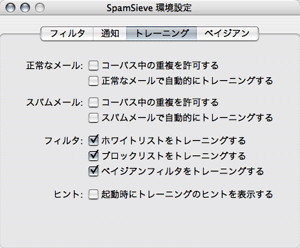Archive for January 2004
Thursday, January 29, 2004
Joel Spolsky:
In most of the English speaking world it is not considered polite to open letters to a Mr. Joel Spolsky by writing “Dear Spolsky.” One might write “Dear Mr. Spolsky,” or “Dear sir,” or perhaps, “Hi Joel!” But “Dear Spolsky” is usually followed by some story about embezzled funds and needing to borrow my bank account.
Bill Bumgarner collects some useful information.
Kudos to Alsoft for providing an easy way for DiskWarrior 3.0 users to update their bootable CDs to 3.0.1. Unfortunately, the updating program, when run on my tower, stopped after I inserted the blank disc, complaining: “The media is not the right type for the requested operation.” It worked correctly on my iBook, although the the resulting 10.2.3 CD won’t boot that machine. I’m still amazed at how much faster 3.x is than previous versions.
Tuesday, January 27, 2004
Adam Engst interviews Bruce Horn, who’s been working on a smart Finder-like browser called iFile:
iFile tracks any changes to the contents of the folders and automatically updates the database as required. For example, the user can drag in the Pictures folder and be able to browse all the images, create collections, etc., without actually copying any files or moving any data. iFile respects your directory structures and never modifies anything directly, in contrast to iPhoto, which copies images into its own directory hierarchy.
He also talks a bit about his contributions to the original Mac OS and how they translated to Mac OS X.
It turns out that Mac OS X still needed a creator mechanism by which individual documents could be opened by specific applications, so this information is stored in the resource fork of the file (of all places, since Apple is discouraging use of the resource fork), rather than simply in a creator code.
I had always thought that Launch Services stored these preferences in the ~/Library/ tree, but it turns out that choosing an application to open a file adds ‘icns’ and ‘usro’ resources to the file (and leaves the creator code intact). How odd. Changing the application back to the one whose creator code tags the file does not delete these resources.
Monday, January 26, 2004
 SpamSieve 2.1.2 is now available. The major change in this release is full support for Apple Mail (more on that later). And a big thank you to Goichi Hirakawa for translating SpamSieve to Japanese.
SpamSieve 2.1.2 is now available. The major change in this release is full support for Apple Mail (more on that later). And a big thank you to Goichi Hirakawa for translating SpamSieve to Japanese.

SpamSieve
Sunday, January 25, 2004
Scott Knaster notes that Amazon now has restaurant menus and free music online.
Erik Barzeski and John Gruber are highly recommending Andy Hertzfeld’s new site about the development of the Mac, and with good reason. My favorite entry so far is about measuring progress by lines of code.
Andy Hertzfeld History Mac
Tuesday, January 20, 2004
Today’s TidBITS turned me on to PDFpen, a nice, lightweight, and scriptable utility for basic PDF editing.
Brent Simmons catalogues the different styles of info and inspector windows on Mac OS X. One thing he doesn’t mention is that some of these windows accept the keyboard focus, while others don’t, and it’s not always easy to tell what a given window will do. I’m old-school on this issue: Command-W should never close a floating window.
Saturday, January 17, 2004
Rick Roe:
Imagine a library where you’re free to browse the stacks, but when you pull a book from the shelf it’s magically transformed into a card which says, “You’re holding one book”… until you set it down on a desk or the checkout counter, at which point it magically changes back into the book. The real world doesn’t work like that—neither should the computer.
Halo didn’t initially work on my iBook G4; it would always quit just after showing the splash screen. After some weeks, Greg Grimes at MacSoft figured out that I should copy the “shaders” folder on the CD into the “Halo” folder on hard drive. Now it works, and the performance is acceptable on the iBook with everything on low quality, which is more than I as expecting. As to Halo itself? The game was worth the wait, though I’m disappointed about the sloppy resolution switching code that messes up all my window positions.
Freshly Squeezed Software has released a public beta (1.0 build 10) of Rock Star, a fun Mac game that melds the iPod’s music trivia game with You Don’t Know Jack-style visuals. The beta seems stable, but you need to be patient when launching it; that took 25 seconds on my machine, and another 20 seconds to load my playlists. Parsability of XML not withstanding, I still think that Apple should open up the APIs that its iApps use to share information.
Wednesday, January 14, 2004
The highly regarded FogBUGZ has been ported to PHP and now works on Mac OS X.
Bug Tracking FogBugz
John Gruber analyzes the HP/Apple iPod deal and Buzz Andersen raves about HP’s new ad featuring “Pictures of You.” Shades of Sina Tamaddon’s “Good Riddance” iMovie?
Mark Pilgrim:
The client is the wrong place to enforce data integrity. It’s just the wrong place. I hear otherwise intelligent people claim that “if everyone did it, it would be okay.” No, if everyone did it, it would be even worse. If you want to do it, of course I can’t stop you. But think about who it will hurt.
Monday, January 12, 2004
To help SpamSieve catch the spam that is circulating right now, I recommend that everyone choose Preferences… from the SpamSieve menu and uncheck the “Honor Habeas headers” checkbox.
Habeas is a service that licenses a haiku to users who agree not to send spam e-mails. The users can then include the following text in their e-mails:
X-Habeas-SWE-1: winter into spring
X-Habeas-SWE-2: brightly anticipated
X-Habeas-SWE-3: like Habeas SWE (tm)
X-Habeas-SWE-4: Copyright 2002 Habeas (tm)
X-Habeas-SWE-5: Sender Warranted Email (SWE) (tm). The sender of this
X-Habeas-SWE-6: email in exchange for a license for this Habeas
X-Habeas-SWE-7: warrant mark warrants that this is a Habeas Compliant
X-Habeas-SWE-8: Message (HCM) and not spam. Please report use of this
X-Habeas-SWE-9: mark in spam to <http://www.habeas.com/report/>.
By default, when SpamSieve sees this text in a message, it assumes that the message is not spam. Why? It used to be a very good indication that the message was good, since Habeas has promised to sue anyone who includes Habeas’s haiku in a spam message. Alas, this no longer seems to be a strong deterrent, and spammers have started including these headers in their messages in order to get through the filters. When you uncheck “Honor Habeas headers,” SpamSieve will treat these messages like all others, which should enable it to catch this latest raft of spam.
Thursday, January 8, 2004
 SpamSieve 2.1.1 increases speed and accuracy, fixes bugs, and tweaks the interface—the usual maintenance update stuff.
SpamSieve 2.1.1 increases speed and accuracy, fixes bugs, and tweaks the interface—the usual maintenance update stuff.
SpamSieve
Tuesday, January 6, 2004
MacInTouch reports that Panther’s Calculator application has some rudimentary graphing capabilities. It’s no Graphing Calculator by a long shot, but it sure beats building your own MathPaper.
Over on the MacJournals list, Mark Twomey posted a link to an article about General Magic’s history. The article is hosted on the rather interesting Web site of Tony Fadell, the lead designer of the iPod, who has a wee bit of experience in the handheld arena.
Update (2020-01-03): The article is now available from the Internet Archive (via Brendan Shanks).
General Magic History Tony Fadell
Mailsmith 2.1 adds some very nice improvements such as fully keyboard-controlled filing of messages (a feature I loved in Emailer; Mailsmith improves it by adding type-selection in the mailbox list), connection status displayed in the Mail Browser window, and search string synchronization between the Simple Query and Find & Replace windows (as well as other applications). Until the end of the week, you can get Mailsmith 2.1 and SpamSieve 2.1 for $79.
Monday, January 5, 2004
Yes, I’m a few days late, and in fact there is much more to catch up on. But, so far, Nicholas Riley has the best new year post.
PageMaker finally is dead, and FrameMaker, though not dead, seems to be even closer than usual. The latest version isn’t very impressive and doesn’t run on Macs. Thankfully, FrameMaker, which has always been reliable, still works in Classic with the same old redraw bugs and ancient interface.
The reason I care about FrameMaker is not so much that I like it, as that I like what it can do. Though there are several alternatives on Windows, I know of no equivalent Mac programs. Number one on my list of FrameMaker likes is that it can create PDFs with clickable links, bookmarks, and other meta-data. Microsoft Word is probably the closest tool to FrameMaker on the Mac, but, unlike its Windows counterpart, it cannot create these rich PDFs. As a result, some of TidBITS’s new Take Control eBooks are created using Word on Windows; the rest have their PDF richness added by hand.
Panther improved Preview by leaps and bounds, which is especially fortunate given the state of Adobe Reader (see also MDJ 2003.12.31). But there is much more to be done. On the viewing side, Preview can’t handle PDF forms or select text in columns. On the creation side, Mac OS X makes it easy to create PDFs—but lowest common denominator ones. Save a Web page with Safari, and all the links die.
John Gruber discusses some old UI habits that give people trouble with Mac OS X. These examples don’t particularly affect me as habits. That is, I don’t accidentally click the desktop to activate the Finder, and I never used the Finder’s keyboard shortcut for creating aliases. However, they do point to some things about Mac OS X that could be improved.
I still think Mac OS X should combine the window-by-window and app-by-app layering policies to get the best of both worlds. Clicking on a window with a modifier key (not Option or Command; they already mean other things) held down should activate the app.
How many OS X users actually minimize windows to the Dock? Not many, I would guess.
I don’t think Apple needed to steal Command-H for hiding the current application, given that we already have the more expressive Option-click.
Using Put Away with items on the trash or desktop…those were the days.
That proxy icons (easily identified by their poofability) don’t behave like normal icons has long been a problem. However, as to the specific example of Script Editor, you can drag an application’s Dock icon onto Script Editor’s Dock icon if you hold down Command-Option. I do that all the time with Script Debugger.
Aliases Finder
Saturday, January 3, 2004
The January issue of ATPM is out.
